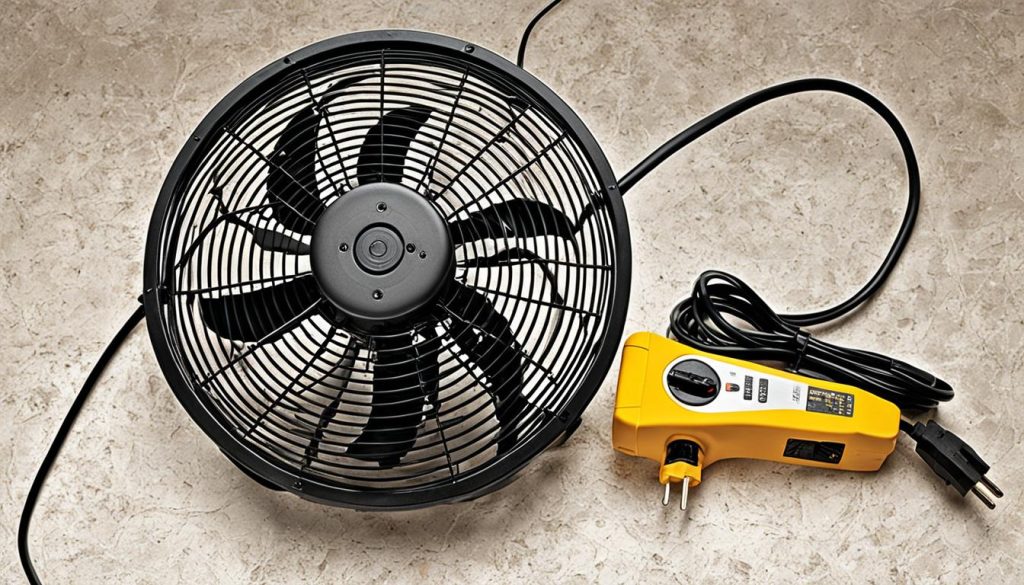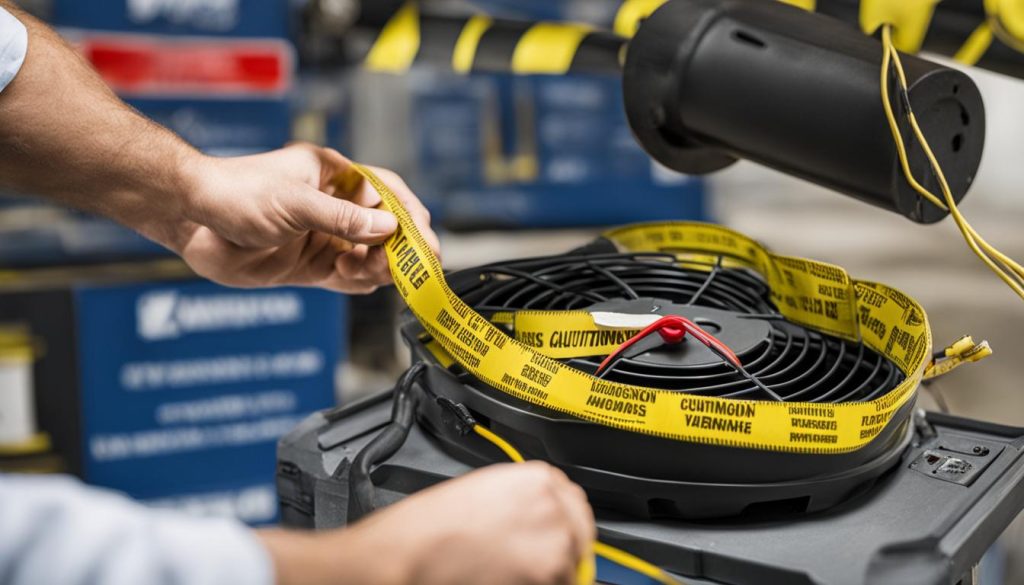extensioncords.site and its partners may earn a commission if you purchase a product through one of our links
Extension cords can provide a convenient solution for using fans in different locations. Whether you need to cool down your bedroom, workspace, or outdoor area, extension cords allow you to place your fan wherever you desire. However, it’s essential to use extension cords safely to prevent hazards and ensure the optimal performance of your fan.
When it comes to connecting a fan to an extension cord, you might have questions like, “Can you plug a fan into an extension cord?” or “Is it safe to use an extension cord for a fan?” In this article, we will provide you with guidelines on how to safely connect your fan to an extension cord and address common concerns related to using extension cords with fans.
Key Takeaways:
- Proper use of extension cords with fans is crucial for electrical safety
- Choose the appropriate extension cord for your fan
- Inspect the extension cord for any damage before use
- Avoid plugging a fan into a power strip
- Follow the provided guidelines for using extension cords with fans
Understanding Extension Cord Ratings and Limitations
When using extension cords with fans, it is crucial to understand their ratings and limitations to ensure electrical safety. Different extension cords are designed for specific purposes and have varying capabilities. Familiarizing yourself with these ratings will help you make informed decisions when connecting your fan to an extension cord.
Extension Cord Ratings
Extension cords are categorized based on their ampacity rating, which indicates the maximum amperage the cord can handle. This rating is usually printed on the packaging or cord itself. It is essential to match the ampacity of the extension cord with the power requirements of your fan.
For example, if your fan has a power rating of 10 amps, you will need an extension cord with an ampacity of at least 10 amps to safely power your fan. Using an extension cord with a lower ampacity can overload the cord, leading to overheating and potential hazards.
Extension Cord Length and Gauge
Another factor to consider is the length of the extension cord. The longer the cord, the higher the electrical resistance, which can result in voltage drops and decreased fan performance. To minimize voltage drops, choose an extension cord that is the appropriate length for your needs.
In addition to length, the gauge of the extension cord plays a crucial role. Thicker cords have lower gauge numbers and can handle more electrical current without generating excessive heat. As a general guideline, if you are using a high-powered fan, opt for a lower gauge extension cord to ensure safe and efficient operation.
Recommended Practices for Connecting a Fan to an Extension Cord
- Inspect the extension cord and fan for any signs of damage such as frayed wires or cracked insulation. Replace any damaged components to maintain electrical safety.
- Always plug the extension cord directly into a grounded wall outlet. Avoid using power strips or surge protectors as they may not have the necessary ampacity rating to accommodate a fan.
- Do not overload the extension cord by plugging in additional devices. The total current draw should not exceed the maximum ampacity of the extension cord.
- Avoid running the extension cord under carpets or rugs, as this can increase the risk of overheating and potential fire hazards.
By understanding extension cord ratings and limitations and following recommended practices, you can safely connect your fan to an extension cord, ensuring both efficient operation and electrical safety.
Tips for Properly Setting Up Your Fan and Extension Cord
Properly setting up your fan and extension cord is essential for safe and effective operation. Follow these tips to ensure a proper setup:
- Choose the right extension cord: When using a fan, it’s important to select an extension cord that can handle the electrical load. Look for an extension cord with an appropriate wire gauge and current carrying capacity.
- Inspect the extension cord: Before connecting your fan, visually inspect the extension cord for any signs of damage, such as frayed wires or cracked insulation. If you notice any issues, replace the extension cord immediately to avoid electrical hazards.
- Position the fan and extension cord: Place the fan in a suitable location that allows for proper airflow and cooling. Make sure the extension cord is positioned in a way that avoids tripping hazards and keeps it away from water or other potential hazards.
- Plug the fan into the extension cord: Use a grounded electrical outlet to plug the extension cord into, ensuring a safe and secure connection. Avoid overloading the extension cord by only connecting the fan and not multiple devices to the same cord.
- Secure loose cords: Use cord clips or cable organizers to secure any loose cords and prevent tripping or entanglement accidents.
By following these tips, you can set up your fan and extension cord properly, ensuring optimal performance and safety.

Extension Cord Gauge and Length Recommendations
| Wire Gauge | Maximum Length (in feet) |
|---|---|
| 16 AWG | 25 |
| 14 AWG | 50 |
| 12 AWG | 100 |
| 10 AWG | 150 |
The Dangers of Misusing Extension Cords
Misusing extension cords can have serious consequences. According to the Electrical Safety Foundation, roughly 3,300 home fires originate from extension cords each year, resulting in 50 deaths and 270 injuries. To avoid these dangers, it’s important to adhere to the following guidelines:
- Use extension cords rated for your device: Ensure that the extension cord’s power rating matches or exceeds the power requirements of your fan. Using an extension cord with insufficient power capacity can overload the cord and cause overheating or fire.
- Avoid daisy-chaining extension cords: Connecting multiple extension cords together, also known as daisy-chaining, increases the risk of overheating and electrical fires. Instead, directly connect your fan to a single, properly rated extension cord.
- Inspect extension cords regularly: Before each use, carefully examine your extension cords for any signs of damage, such as frayed wires or exposed conductors. Do not use cords that are damaged, as they pose a safety risk.
- Do not run cords under carpets or rugs: Placing extension cords under carpets or rugs can restrict airflow and cause overheating. Always ensure that cords are placed in an open area with sufficient ventilation.
- Avoid overloading extension cords: Extension cords have a maximum power rating, and exceeding this limit can lead to overheating and fire. Be mindful of the wattage of your fan and other devices plugged into the same extension cord.
By following these guidelines, you can use extension cords with fans safely, minimizing the risk of electrical hazards and ensuring the well-being of yourself and your home.

Conclusion: Stay Safe and Cool With Proper Fan and Extension Cord Use
Proper use of extension cords with fans is crucial for electrical safety. To ensure a safe and effective connection between your fan and an extension cord, it is important to follow these guidelines:
- Choose the appropriate extension cord: Select an extension cord that is suitable for your fan’s power requirements. Refer to the manufacturer’s guidelines to ensure compatibility.
- Inspect for damage: Before connecting your fan, carefully inspect the extension cord for any signs of wear, frayed wires, or damage. If you notice any issues, do not use the cord and replace it immediately.
- Avoid overloading: Do not overload the extension cord by plugging in multiple devices. Make sure the extension cord has the capacity to handle the power load of your fan alone.
By prioritizing electrical safety, you can stay cool and comfortable without compromising the well-being of yourself and your home. Following these safety guidelines will help prevent hazards such as fires and injuries.
Stay safe and enjoy the benefits of using a fan with an extension cord responsibly. Remember, your comfort should never come at the expense of your safety.
FAQ
Can I plug a fan into an extension cord?
Yes, you can plug a fan into an extension cord. However, it’s important to use it safely to avoid hazards. Follow the guidelines mentioned in this article for proper use and setup.
Can I use an extension cord for a portable fan?
Yes, you can use an extension cord for a portable fan. Just make sure to choose the appropriate extension cord and follow the recommended practices for connecting a fan to an extension cord.
Is it safe to connect a fan to a power strip?
It is generally not recommended to connect a fan to a power strip. Power strips are designed for low-power devices and may not be able to handle the high wattage of a fan. It’s safer to connect your fan directly to a wall outlet or use a heavy-duty extension cord specifically designed for fans.
What are the guidelines for using extension cords with fans?
When using extension cords with fans, make sure to choose the appropriate cord for the wattage of your fan, inspect the cord for any damage before use, avoid overloading the cord with additional devices, and never run the cord under carpets or through doorways where it can be pinched or damaged.
Are there any safety precautions I should take when using an extension cord for a fan?
Yes, there are several safety precautions you should take when using an extension cord for a fan. These include avoiding using damaged cords, not exceeding the maximum wattage rating of the cord, keeping the cord away from heat sources and water, and never using the cord if it feels hot to the touch.
What are the dangers of misusing extension cords with fans?
Misusing extension cords with fans can lead to fires and injuries. According to the Electrical Safety Foundation, roughly 3,300 home fires originate from extension cords each year, resulting in 50 deaths and 270 injuries. It’s important to follow the guidelines mentioned in this article to avoid these dangers.


